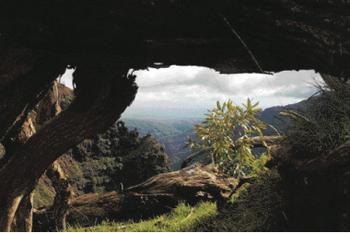LIHU‘E — State officials are working to restore the community’s confidence in the Department of Land and Natural Resources as it continues to push a proposal to make $240 million in park and harbor upgrades over the next five years.
LIHU‘E — State officials are working to restore the community’s confidence in the Department of Land and Natural Resources as it continues to push a proposal to make $240 million in park and harbor upgrades over the next five years.
“Our parks are in shameful condition. It’s embarrassing,” DLNR Chair Laura Thielen said in an interview last week. “We can do these improvements in a timely manner when we have the money to go forward. … We know we’re going to have to earn the public trust on that.”
Residents are invited to attend an informational meeting on the “Recreational Renaissance” plan at 5 p.m., Friday, at the Chiefess Kamakahelei Middle School dining room in Lihu‘e.
“We expect they’ll have a lot of ideas,” Thielen said. “We want to gather that input.”
The plan proposes capital improvement projects statewide, including $63.3 million for Kaua‘i, $40.9 million for Maui County, $58.3 million for Hawai‘i, and $72.6 million for O‘ahu.
“This is going to cure some of the eyesores we’ve been having,” said Joe Borden, who heads the Kaua‘i branch of the DLNR’s boating division.
The focus is on restoring and preserving Hawai‘i’s state parks, various popular trails and ocean recreation facilities, and represents a new and innovative approach to developing and maintaining outdoor recreational properties in the state, a Monday press release says.
“People have been waiting a long time for these improvements,” Thielen said. “We’re saying we can go out and raise the money and address the whole problem and not try to tackle it bit by bit.”
To pay the debt on the proposed loans, the plan calls for modest fee increases at harbors and parks to supplement revenue from rents on state commercial and industrial lands.
Multiple capital improvement projects are planned for both land- and ocean-based recreational infrastructure on all islands, the release says.
In the first year of the plan, $31.3 million in projects are ready to bid for construction. In its second year, $20.6 million in projects are ready to bid for construction.
“We certainly can raise the money for the first two years,” Thielen said. “Why shouldn’t we start?”
Legislation is needed in part because the one-time $240 million upgrade to park and boating facilities is to be financed by $40 million in general obligation bonds and $200 million in reimbursable general obligation bonds.
House Bill 980 and the plan’s companion measure, Senate Bill 765, are working their way through the state Legislature.
HB980, which “fortifies the recreational renaissance program” through various amendments to state law, was heard Monday by the Committee on Water, Land and Ocean Resources.
SB765 was referred to the Water, Land, Agriculture and Hawaiian Affairs and Ways and Ways and Means committees, but hearings have not been scheduled.
The reimbursable bonds are to be paid for by the revenue generated from state lands, including a proposed development of at least 119 new acres of light industrial space at Keehi lagoon.
Borden said the department’s new approach is more cooperative.
“In the past, we would compete for Laura’s attention,” Borden said. “Now, it’s a we.”
Alvin Kyono, the Kaua‘i Branch manager of the DLNR’s Division of Forestry and Wildlife, said the plan is a “real positive step.”
“Finally, we might be able to get the funds that we need to do the projects,” he said. “A lot we’re asking for is stuff we’ve been asking for.”
The public information meetings will begin with a brief presentation by a DLNR staff team representing key divisions involved in the plan (State Parks, Boating and Ocean Recreation, Forestry and Wildlife, Engineering and Land).
They will then provide: an overview of the financial plan; explanation of the coordinated team approach to developing and implementing the plan; an explanation of the statewide bundling of projects as a cost-effective way to get capital improvement projects completed; and give a description of the plan’s asset Management Program. A question-and-answer period will follow.
The next portion of the meeting will focus on descriptions of specific capital improvement projects planned for Kaua‘i, again followed by a question-and-answer period.
“Although the challenges are real, continuing to do ‘business as usual’ will mean Hawai‘i’s parks, beaches, trails, campgrounds, cabins, small boat harbors and ramps will fall further into disrepair, our environmental and cultural resources will be further degraded, we will have increasingly unsafe recreational spaces for residents and visitors alike, and we will lose educational opportunities to promote kuleana and stewardship,” Thielen said in the release.
Other highlights of the plan include:
∫ Dedicated revenues generated from limited fees, leases and concessions in parks and small boat harbors to support facility maintenance, restoration, interpretive and education programs and increase security of recreational spaces.
∫ Adopting national model standards for maintenance schedules to upgrade park trails and small boat harbor standards, and reorganizing DLNR to maximize efficiency and professionalism in maintaining recreational facilities and spaces.
∫ Developing new land and ocean recreational opportunities through public-private partnerships to support long-term demand for additional recreational opportunities and relieve pressure on a limited number of popular recreational spaces.
For more information, visit hawaii.gov/dlnr/recreate.
• Nathan Eagle, staff writer, can be reached at 245-3681 (ext. 224) or neagle@kauaipubco.com


